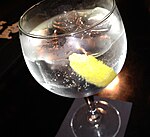Cocktail glass

A cocktail glass is a stemmed glass with an inverted cone bowl, mainly used to serve straight-up cocktails. The term cocktail glass is often used interchangeably with martini glass, despite them differing slightly.
Today, the glass is used to serve a variety of cocktails, such as the Martini and its variations (French Martini, Vodka Martini, Espresso Martini, Appletini), Manhattan, Brandy Alexander, Pisco Sour, Negroni, Cosmopolitan, Gimlet, and the Grasshopper.[1]

History
Invented in the late 19th century, its form derives from the fact that all cocktails are traditionally served chilled and contain an aromatic element. Thus, the stem allows the drinker to hold the glass without affecting the temperature of the drink, an important aspect due to the lack of added ice which in other drinks serves to cool the drink,[2] and the wide bowl places the surface of the drink directly under the drinker's nose, ensuring the aromatic element has the desired effect. In the modern day cocktail glasses without stems are common, however, these glasses warm very quickly, a phenomenon the original stem addressed.[3]
Martini glass
Although the terms 'cocktail glass' and 'martini glass' are often used interchangeably,[4][5] the former is slightly smaller, more rounded (in contrast with the latters purely conical shape), features a shorter stem, and a narrower rim.
Despite a popular story that says the martini glass was invented during Prohibition so as in the case of a raid on a speakeasy, the large rim allows the drink to be easily disposed of,[2] the martini glass was formally introduced in the 1925 Paris Exhibition as a modernist take on the Champagne coupe[6], and wasn't originally used as it is today: in films of the 1920s it is shown to be used to hold champagne, like the coupe. However, despite the design taking influence from the geometric aesthetics of the eras architecture, interiors and furnishings,[7] it was designed less for aesthetics and more for functionality, with the longer stem further decreasing drink heating from body heat already offered by the shorter stem, and the widened brim increasing surface area with the air, supposedly allowing the gin, the main ingredient in martinis, to be able to release its odour. Steeply sloping sides prevent ingredients separating, and also serve to support a toothpick or olives on a cocktail skewer.[2]
The Martini glass has in modern times fallen out of favour due to their tendency to spill drinks, and the coupe is sometimes used instead.[7][8]
Sizes
A standard cocktail glass contains 90 to 300 millilitres (3 to 10 US fl oz),[9] though originally they were around 120 millilitres (4 US fl oz) in size.[10]
Oversized cocktail glasses, ranging in capacity from 180 ml (6 US fl oz) to large glasses of 350 ml (12 US fl oz) or more are available.
See also
References
- ^ "Cocktail Glass". Drinks Mixer. Retrieved 5 October 2017.
{{cite web}}: Cite has empty unknown parameter:|dead-url=(help) - ^ a b c "The History of the Martini Glass". Sipsmith London. 27 January 2014. Retrieved 5 October 2017.
{{cite web}}: Cite has empty unknown parameter:|dead-url=(help) - ^ Graham, Colleen (26 July 2017). "The Bar Glassware Tour: Cocktails, Beer and Wine Glasses". The Spruce. Retrieved 5 October 2017.
{{cite web}}: Cite has empty unknown parameter:|dead-url=(help) - ^ Hess, Robert (2008). The Essential Bartender's Guide. New York: Mud Puddle Books. p. 51. ISBN 978-1-60311-150-8.
- ^ Herbst, Sharon Tyler; Herbst, Ron (1998). The Ultimate A-Z Bar Guide. New York: Broadway Books. p. 9. ISBN 0-7679-0197-5.
- ^ Locke, Karen. "Origin Stories: The History Behind the Glass in Which You Drink". Sip Northwest. Winter 2018: 20.
- ^ a b Munro, Lizzie (17 August 2016). "The Life and Death of the Martini Glass". Punch Drink. Retrieved 5 October 2017.
{{cite web}}: Cite has empty unknown parameter:|dead-url=(help) - ^ Erdos, Joseph (17 April 2012). "The Glass Shaped Like Marie Antoinette's Anatomy". The Huffington Post. Retrieved 5 October 2017.
{{cite web}}: Cite has empty unknown parameter:|dead-url=(help) - ^ Herbst, Sharon Tyler; Herbst, Ron (1998). The Ultimate A-Z Bar Guide. New York: Broadway Books. p. 8. ISBN 0-7679-0197-5.
- ^ Hess, Robert (2008). The Essential Bartender's Guide. New York: Mud Puddle Books. p. 51. ISBN 978-1-60311-150-8.

